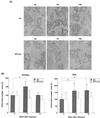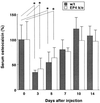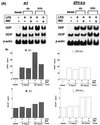Impaired bone resorption by lipopolysaccharide in vivo in mice deficient in the prostaglandin E receptor EP4 subtype
- PMID: 11083800
- PMCID: PMC97785
- DOI: 10.1128/IAI.68.12.6819-6825.2000
Impaired bone resorption by lipopolysaccharide in vivo in mice deficient in the prostaglandin E receptor EP4 subtype
Abstract
In a previous study we showed that the involvement of EP4 subtype of the prostaglandin E (PGE) receptor is crucial for lipopolysaccharide (LPS)-induced osteoclast formation in vitro. The present study was undertaken to test whether EP4 is actually associated with LPS-induced bone resorption in vivo. In wild-type (WT) mice, osteoclast formation in vertebrae and tibiae increased 5 days after systemic LPS injection, and urinary excretion of deoxypyridinoline, a sensitive marker for bone resorption, statistically increased 10 days after injection. In EP4 knockout (KO) mice, however, LPS injection caused no significant changes in these parameters throughout the experiment. LPS exposure for 4 h strongly induced osteoclast differentiation factor (ODF) mRNA expression in primary osteoblastic cells (POB) both from WT and EP4 KO mice, and this expression was not inhibited by indomethacin, suggesting prostaglandin (PG) independence. LPS exposure for 24 h further induced ODF expression in WT POB, but not in EP4 KO POB. Indomethacin partially inhibited ODF expression in WT POB, but not in EP4 KO POB. These data suggest that ODF is induced both PG dependently and PG independently. LPS exposure for 24 h induced slightly greater osteoclastgenesis inhibitory factor (OCIF) mRNA expression in EP4 KO than in WT POB. These findings suggest that the reduced ODF expression and apparently increased OCIF expression also are responsible for the markedly reduced LPS-induced osteoclast formation in EP4 KO mice. Our results show that the EP4 subtype of the PGE receptor is involved in LPS-induced bone resorption in vivo also. Since LPS is considered to be largely involved in bacterially induced bone loss, such as in periodontitis and osteomyelitis, our study is expected to help broaden our understanding of the pathophysiology of these conditions.
Figures




Similar articles
-
The role of prostaglandin E receptor subtypes (EP1, EP2, EP3, and EP4) in bone resorption: an analysis using specific agonists for the respective EPs.Endocrinology. 2000 Apr;141(4):1554-9. doi: 10.1210/endo.141.4.7405. Endocrinology. 2000. PMID: 10746663
-
Effects of prostaglandin E2 on gene expression in primary osteoblastic cells from prostaglandin receptor knockout mice.Bone. 2002 Apr;30(4):567-73. doi: 10.1016/s8756-3282(02)00683-x. Bone. 2002. PMID: 11934647
-
Suppression of osteoprotegerin expression by prostaglandin E2 is crucially involved in lipopolysaccharide-induced osteoclast formation.J Immunol. 2004 Feb 15;172(4):2504-10. doi: 10.4049/jimmunol.172.4.2504. J Immunol. 2004. PMID: 14764723
-
The roles of osteoprotegerin and osteoprotegerin ligand in the paracrine regulation of bone resorption.J Bone Miner Res. 2000 Jan;15(1):2-12. doi: 10.1359/jbmr.2000.15.1.2. J Bone Miner Res. 2000. PMID: 10646108 Review.
-
[Role of EP4 receptor in bone resorption induced by PGE].Nihon Yakurigaku Zasshi. 2001 Apr;117(4):293-7. doi: 10.1254/fpj.117.293. Nihon Yakurigaku Zasshi. 2001. PMID: 11338379 Review. Japanese.
Cited by
-
The growth of malignant keratinocytes depends on signaling through the PGE(2) receptor EP1.Neoplasia. 2001 Sep-Oct;3(5):402-10. doi: 10.1038/sj.neo.7900182. Neoplasia. 2001. PMID: 11687951 Free PMC article.
-
Notch signaling inhibition protects against LPS mediated osteolysis.Biochem Biophys Res Commun. 2019 Aug 6;515(4):538-543. doi: 10.1016/j.bbrc.2019.05.166. Epub 2019 Jun 5. Biochem Biophys Res Commun. 2019. PMID: 31176486 Free PMC article.
-
Role of the A20-TRAF6 axis in lipopolysaccharide-mediated osteoclastogenesis.J Biol Chem. 2011 Feb 4;286(5):3242-9. doi: 10.1074/jbc.M110.150300. Epub 2010 Dec 2. J Biol Chem. 2011. PMID: 21127049 Free PMC article.
-
Ca2+-independent phospholipase A2β-derived PGE2 contributes to osteogenesis.Prostaglandins Other Lipid Mediat. 2022 Feb;158:106605. doi: 10.1016/j.prostaglandins.2021.106605. Epub 2021 Dec 16. Prostaglandins Other Lipid Mediat. 2022. PMID: 34923151 Free PMC article.
-
The gut microbiota can be a potential regulator and treatment target of bone metastasis.Biochem Pharmacol. 2022 Mar;197:114916. doi: 10.1016/j.bcp.2022.114916. Epub 2022 Jan 15. Biochem Pharmacol. 2022. PMID: 35041811 Free PMC article. Review.
References
-
- Agarwall S, Piesco N P, Johns L P, Riccelli A E. Differential expression of IL-1 beta, TNF-alpha, IL-6, IL-8 in human monocytes in response to lipopolysaccharides from different microbes. J Dent Res. 1995;74:1057–1065. - PubMed
-
- Aznar C, Fitting C, Cavaillon J M. LPS-induced production of cytokines by bone marrow-derived macrophages: destruction between intracellular IL-1 production and IL-1 release. Cytokine. 1990;2:259–265. - PubMed
-
- Birkeadal-Hansen H. Role of cytokines and inflammatory mediators in tissue destruction. J Periodontal Res. 1993;28:500–510. - PubMed
-
- Bom-van Noorloos A A, van der Merr J W, van de Gevel J S, Schepens E, van Steenbergen T J, Burger E H. Bacteroides gingivalis stimulates bone resorption via interleukin production by mononuclear cells. The relative role for B. gingivalis endotoxin. J Clin Periodontol. 1990;17:409–413. - PubMed
Publication types
MeSH terms
Substances
LinkOut - more resources
Full Text Sources
Molecular Biology Databases
Research Materials

